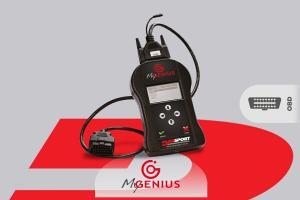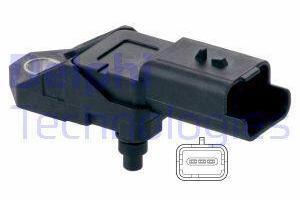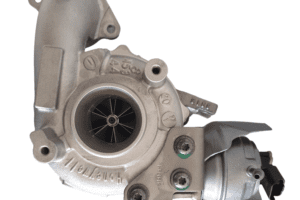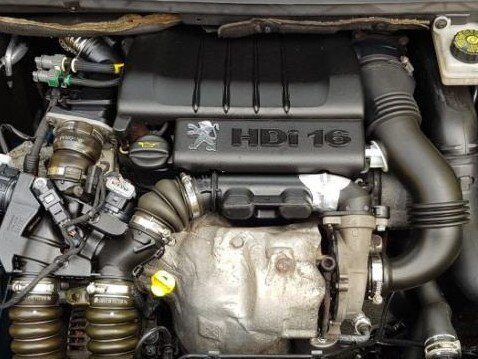Peugeot Partner 1.6 HDI 16v 110 Stage 1 Remap – DPF safe (138 BHP
| 280 Nm
)
In Scandinavian countries, and sometimes rarely in the UK there is a 1.6 16v Peugeot Partner variant which has the GT15 turbo and a power output of 110 BHP. If you’re unsure which one you have, simply check the part number on the side of the turbo charger.
Our stage 1 remap for the Peugeot Partner 1.6 HDI 16v 110 provides constant and increased torque through the entire rev range whilst remaining well within the safe limits of your clutch, dual mass flywheel and turbo charger. The torque delivery will be smooth and stable and it won’t drop off in the higher RPMs like the stock mapping, making your 1.6 HDI much more fun to drive.
We’ve designed our stage 1 remap to run cleanly and in unison with the DPF system, this means that there is no increased risk of clogging the DPF filter as long as regular long journeys are undertaken by the vehicle. Most customers also see a small economy gain during normal driving conditions.
You can program the ECU yourself using our online remapping service. For this we recommend to use the Kess V2 tool or DimSport MyGenius which is available in our webshop. If you prefer to send the ECU to us for the programming work, you can use our postal remap service.
Price:
- Program yourself with the MyGenius OBD tool, includes a Stage 1 Remap for just £290!
- Already have a programming tool? Use our Online remap service for just £150
- Send us your ECU – Postal Remap Service from £200
- Drive in or mobile remap from £325
-

MyGenius OBD Tool
£190.00 – £789.00 Select options This product has multiple variants. The options may be chosen on the product page -

Online Remap Service
£60.00 – £350.00 Select options This product has multiple variants. The options may be chosen on the product page -

Postal Remap Service
£75.00 – £450.00 Select options This product has multiple variants. The options may be chosen on the product page -

Bosch EDC16 1.4 1.6 HDI ECU
£265.00 – £375.00 Select options This product has multiple variants. The options may be chosen on the product page
Peugeot Partner 1.6 HDI 16v 110 Stage 1 + Full Power Remap (143 BHP
| 295 Nm
)
The full power stage 1 remap for the Peugeot Partner 1.6 HDI 16v 110 from HDI Tuning will deliver 143BHP and 295Nm. You can run a performance down pipe and exhaust system when using the Stage 1+ Remap.
We’ve developed our 1.6 remaps not only to give optimal performance, but also to remain within the limits of the stock hardware of your vehicle such as the dual mass flywheel and the clutch, and most importantly the turbo.
The Stage 1+ Remap is more aggressive and when used on a vehicle with a particle filter there is an increased risk of clogging, it’s important to do regular long journeys to avoid that risk.
Price:
- Program yourself with the MyGenius OBD tool, includes a Stage 1 Remap for just £290!
- Already have a programming tool? Use our Online remap service for just £150
- Send us your ECU – Postal Remap Service from £200
- Drive in or mobile remap from £325
Stage 2
On the 1.6 110 model we generally skip the stage 2 step. The reason for this is so that we don’t over stress the turbo, we like to keep our remaps safe and reliable. Instead, if we want more power we need to fit a larger or stronger turbo charger such as a GTD1244VZ and also a larger intercooler. That’s not to say you won’t get more power if you’re running a Stage 1+ remap with an intercooler and exhaust upgrade, you definitely will, we just won’t push the turbo any harder than the Stage 1+ settings as these have proven to be safe and reliable over many years of testing for a standard GT1544V turbo.
Peugeot Partner 1.6 HDI 16v 110 Stage 3 Remap – Option 2 GTD1244VZ (155 BHP
| 320 Nm
)
We have a great option for a turbo and injector upgrade, this upgrade is almost a direct fit and uses the turbo from the newer 1.6 engine.
The GTD1244VZ uses fourth generation Garrett GTD technology which means earlier spool and better top end power. Another plus is that this turbo fits directly on to the stock exhaust manifold. Here’s a fitment guide for a standard GTD12 designed for a reliable 155 BHP with 320Nm.
To run this remap we also require you to upgrade to the 0445110297 injectors, fit a 3.1 Bar MAP sensor, performance down pipe and an EGR blank (for track use only). It’s well worth while to fit an uprated intercooler, with this you can push for nearer to 160 BHP (110 models from 2007 onwards will already have the 297 injectors fitted). Price:
- Program yourself with MyGenius OBD tool, including HDI Tuning Stage 3 Software £399
Peugeot Partner 1.6 HDI 16v 110 Stage 3 Remap – Option 3 (185 BHP
| 370 Nm
)
The next step up is to build a hybrid GTD12 using a 49mm compressor wheel (please contact for full specifications before building your turbo).
To run this remap we also require you to upgrade to the 0445110297 injectors, fit a 3.1 Bar MAP sensor, performance down pipe and an EGR blank (for track use only). You will also need a large front mount intercooler with a straight through exhaust system of 2.5 inch.
The clutch will need to be upgraded to at least a stage 2 Kevlar clutch, or better is a full stage 3 ceramic paddle clutch.
Please see here for the full fitment guide.
Price:
- Program yourself with MyGenius OBD tool, including HDI Tuning Stage 3 Software £399
-

3.1 Bar MAP sensor upgrade
£46.97 Read more -

GTC12 GTD1244VZ Turbo
£529.00 – £879.00 Select options This product has multiple variants. The options may be chosen on the product page
Stage 4 (205 BHP
| 380 Nm
)
HDI Tuning have developed a completely custom turbo manifold kit to fit the 1.6 16V engine. The turbo used is a TF035 from a 2.2 Mitsubishi engine with a very modern VNT system. This turbo offers excellent spool and crazy top end power.
Upgrades required:
- TF035 manifold;
- TF035 turbo;
- 3.1 bar or 4 bar MAP sensor;
- Turbo down pipe;
- 2.5 inch exhaust system;
- Large FMIC;
- 0445110297 injectors;
- The clutch will need to be upgraded to a full stage 3 ceramic paddle clutch.
Which vehicles are covered?
The power figures quoted on this page are applicable to the following vehicle models if fitted with a Bosch EDC16 ECU and the 1.6 16v DV6TED4 HDI engine:
Peugeot 206 1.6 HDI 16v 110 BHP
Peugeot 207 1.6 HDI 16v 110 BHP
Peugeot 307 1.6 HDI 16v 110 BHP
Peugeot 308 1.6 HDI 16v 110 BHP
Peugeot 407 1.6 HDI 16v 110 BHP
Peugeot Partner 1.6 16v HDI Van – Scandinavian models fitted with the GT1544v turbo
Citroen C2 1.6 HDI 16v VTS 110 BHP
Citroen C3 1.6 HDI 16v 110 BHP
Citroen C4 1.6 HDI 16v 110 BHP
Citroen C5 1.6 HDI 16v 110 BHP
Citroen Berlingo 1.6 16v HDI Van – Scandinavian models fitted with the GT1544v turbo
If your vehicle is not listed directly but you have the 1.6 16v DV6TED4 engine with the GT1544V turbo you can assume these figures will be correct.
Programming Methods – OBD programming or Bench Programming
There are two variants of the 1.6 EDC16 ECU, EDC16C3 and EDC16C34. The C3 ECU has a 1MB flash whilst the C34 has a 2MB flash.
Recommended programming method:
Program over OBD using the Dimsport MyGenius standalone tool
The Dimsport MyGenius tool is the safest, easiest and most reliable way to program your ECU from home. Simply connect to the OBD port and let the tool do the work, no need to remove your ECU or bench program for most ECU types. For more information have a read here
Programming via OBD EDC16C34
- Obtain a suitable programming tool; we recommend to use Dimsport MyGenius, you can also use Kess V2.
- Install the tool to a reliable laptop.
- Connect to the OBD port of your car, make sure you have backup chargers to the vehicle battery and the laptop battery.
- ID the ECU and then take a read of the ECUs flash memory.
- Email the software to remap@hdi-tuning.co.uk along with a description of the remap you require.
- Send payment through our webshop.
- We will modify the software and send back to you. This normally takes less than 2 to 3 hours during working days.
- Using the same tool, ID then write to the ECU. This will overwrite the ECUs flash memory, it’s important not to interrupt the process. If you encounter any problems we can fix the ECU for you so there’s absolutely nothing to worry about.
- Let your engine warm up and then take the car for a spin, enjoy the extra power!
Programming via BDM100 EDC16C3 & EDC16C34
- Order a suitable tool such as Kess KTAG or BDM100.
- Install the tool to a reliable laptop.
- The ECU must be removed from the vehicle, and then the tabs on the lid can be carefully pried open and the casing of the ECU removed.
- Using a pogo spring probe connect to the ECU board, power the ECU to the ECU connector plugs as described by your programming tool.
- ID the ECU and then take a read of the ECUs memories for a backup (please save separately, and not as a combined file). For EDC16C3 the performance maps are in the 1MB flash. For EDC16C34 the performance maps are stored in the 2MB flash memory.
- Email the software to remap@hdi-tuning.co.uk along with a description of the remap you require.
- Send payment through our webshop.
- We will modify the software and send back to you. This normally takes less than 2 to 3 hours during work days.
- Using the same tool, ID then write to the ECU. This will overwrite the ECUs memory, it’s important not to interrupt the process. If you encounter any problems we can fix the ECU for you so there’s absolutely nothing to worry about (You can always repair an ECU if you take a full BDM backup of all memories).
- Straighten the lid on the ECU and seal with a little silicone.
- Refit the ECU and start the engine.
- Let your engine warm up and then take the car for a spin, enjoy the extra power!


